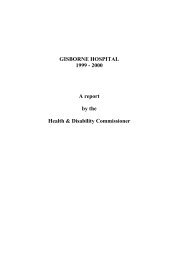09HDC01565 - Health and Disability Commissioner
09HDC01565 - Health and Disability Commissioner
09HDC01565 - Health and Disability Commissioner
Create successful ePaper yourself
Turn your PDF publications into a flip-book with our unique Google optimized e-Paper software.
<strong>Health</strong> <strong>and</strong> <strong>Disability</strong> <strong>Commissioner</strong><br />
196. On Day 3, RN Ms J had no concerns about the patients in SCU <strong>and</strong> accordingly went<br />
to the seminar room at 6.45am to give the h<strong>and</strong>over. (We do not know whether Mr<br />
A‘s respiratory rate would have constituted a concern had this been checked <strong>and</strong><br />
documented throughout the night.) Her actions were therefore consistent with usual<br />
ward practice.<br />
197. However, this suggests a laxity that was not appropriate for the SCU. While holding<br />
h<strong>and</strong>over in a different room may be preferable in terms of optimising patient<br />
confidentiality <strong>and</strong> privacy, these issues can be managed by the nursing staff. My<br />
nursing expert notes ―a picture of delays in ‗seeing‘ the patients first thing‖. The<br />
h<strong>and</strong>over practice that had evolved on the SCU did not support nurses to maintain an<br />
appropriate level of surveillance.<br />
Oxygen saturation monitoring<br />
198. There is an important matter that I have been unable to resolve. RN Ms J states that<br />
Mr A was on an oxygen saturation monitor throughout her shift, <strong>and</strong> she believes he<br />
was still on the monitor during morning h<strong>and</strong>over. She recalls that the monitor was set<br />
to alarm if Mr A‘s oxygen saturation levels fell below 92%, <strong>and</strong> the fact that the alarm<br />
did not sound during her shift indicated that his oxygen levels did not fall below this<br />
level. RN Ms J last saw Mr A at 6.15am. RN Ms K recalls that when she found Mr A<br />
at 7.30am, the monitor was switched off <strong>and</strong> not attached.<br />
199. CDHB states that it is possible for patients to turn monitors off if they have observed<br />
staff doing this. Mr A had had a disturbed night <strong>and</strong> was awake on several occasions.<br />
There is nothing in the records or information provided by staff subsequently to<br />
indicate that the monitor bothered him.<br />
200. I have been provided with no information to indicate that the monitor was faulty <strong>and</strong> it<br />
is known with certainty that the monitor was on at 5am as recordings were taken at<br />
that time. There are a number of other possible explanations as to what occurred<br />
subsequently: Mr A got up <strong>and</strong> turned the monitor off; someone else turned the<br />
monitor off; RN Ms J‘s recollection that Mr A was connected to the monitor<br />
throughout her shift is incorrect; or RN Ms K‘s recollection that the monitor was off is<br />
incorrect.<br />
201. It is unlikely that RN Ms K was mistaken. If Mr A had been connected to the monitor<br />
<strong>and</strong> it was on, it would presumably have alarmed when Mr A stopped breathing, some<br />
time between 6.35am (when RN Ms J heard Mr A snoring) <strong>and</strong> 7.30am (when RN Ms<br />
K found Mr A unresponsive).<br />
202. Further than this, I have insufficient information to resolve this matter.<br />
203. I note that my neurosurgical expert, Dr Nye, considers continuous oxygen saturation<br />
monitoring to be ―desirable‖ for the first 24 hours postoperatively. Ms Hewson refers<br />
to the decision as to whether continuous monitoring is necessary as ―generally resting<br />
with the nurses‖. She states further that continuous monitoring is desirable in patients<br />
who may not breathe deeply, who may breathe too slowly, or who have periods of no<br />
breathing. There is no evidence in the records that any of these applied to Mr A.<br />
5 September 2012 34<br />
Names have been removed (except Canterbury DHB <strong>and</strong> the experts who advised on this case) to<br />
protect privacy. Identifying letters are assigned in alphabetical order <strong>and</strong> bear no relationship to the<br />
person’s actual name.
















